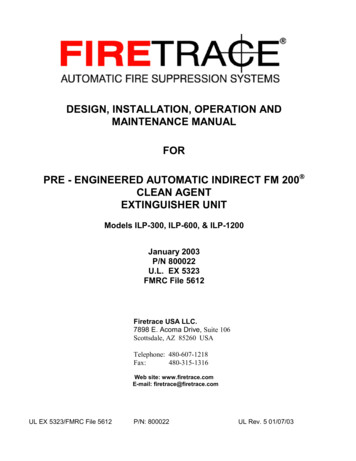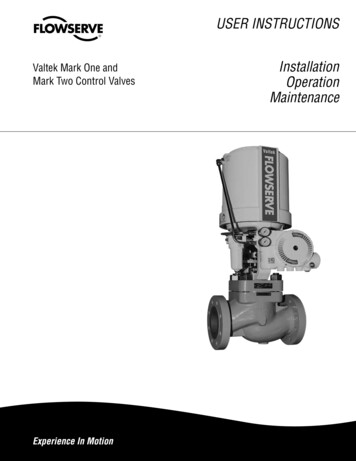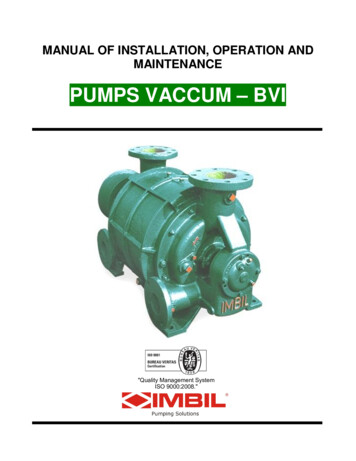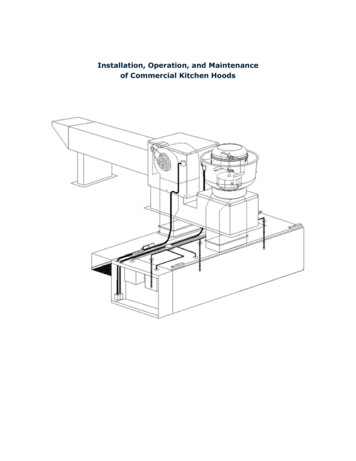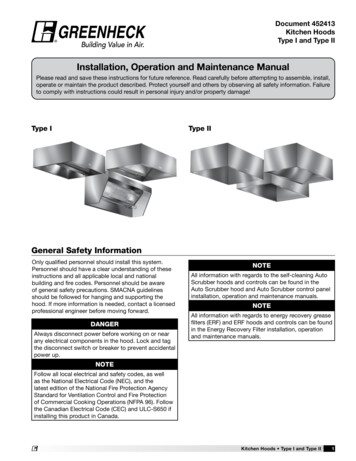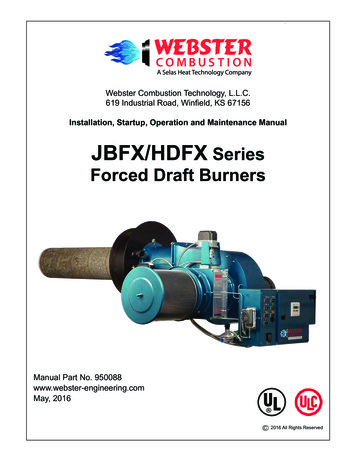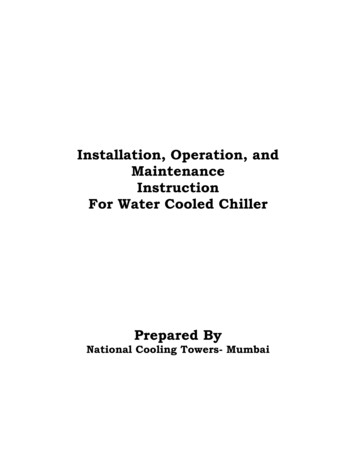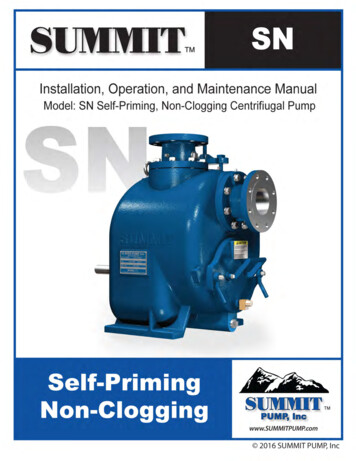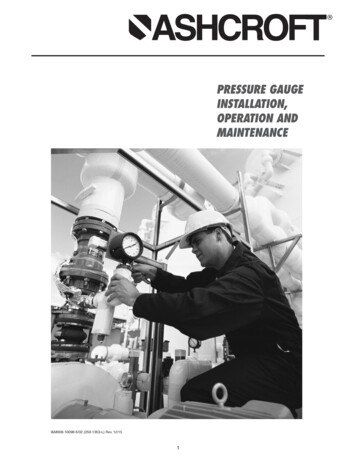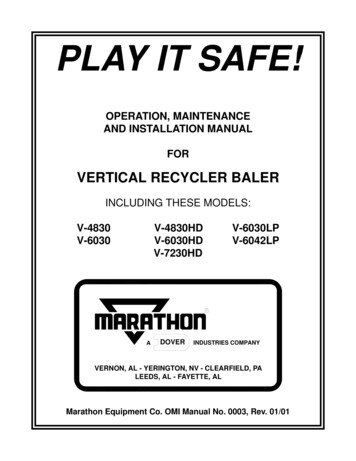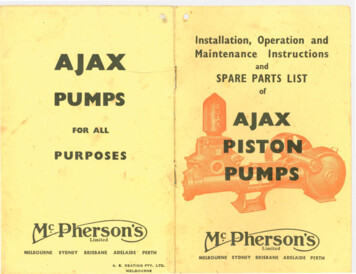
Transcription
Installation, Operation andMaintenance InstructionsAJAXandSPARE PARTS LISTofPUMPSAJAXFOR ALL ISTONPURPOSESI'PUMPS Pli [§ODSMELBOURNESYDNEYBRISBANEADELAIDE Pli r.§on·sPERTHMELBOURNEA. II:, Kl!ATINGlPTY. LTD,MELBOURN!!SYDNEYBRISBANEADELAIDEPERTH----- -------- -.:
Installation, Operation andMaintenance Instructions.,andSPARE PARTS DEPERTH
LOCATION:Instal the pump as near the source ofsupply as possible.Never exceed therecommended distance and height from thelowest level of the source of supply. A dryplace should be chosen for the installationof a motor driven unit. Allow sufficientspace in front of the pump for withdrawingthe plunger rod and liner.FOUNDATION :This should be sufficiently substantial tosupport the pump and prevent movement.PIPE SUPPORT:All piping should be supported independently near the pump. Pipes must registerwith the pump connections without beingstrained into position.SUCTION PIPE:The suction line in particular must be airtight, as even a small leak may impair theoperation of the pump. The· pipe shouldnever be smaller than the pump connection, and may, with advantage, be a sizelarger.Avoid abrupt changes in pipediameters. The suction line must be asshort and direct as possible. Avoid sharpturns, use bends rather than elbows.When laying the line a uniform gradeshould be maintained, rising toward thepump the whol e way. Particular careshould be taken to avoid humps or depressions in the pipeline, otherwise air maybe trapped in the pipe. This would greatlyreduce the flow. It is important to avoidthese air pockets whether the pump isabove or below the supply level. Ensure2that the end of the suction line is alwayswell bel ow the surface of the water; whenthe pump is operating, check to see that avortex do es not form.FOOTVALVE:If a footvalve is used, it should havl anarea at least H times that of the suctionpipe. If a strainer is used, it should havea clear area 3 to 4 times that of the suctionpipe.DELIVERY PIPE:The size of the delivery pipe should beselected so that the friction head is notexcessive. If delivery pipe is too small,frictional head is very greatly increased,consequently more power is required todrive the pump. Avoid sharp turns, usebends rather than elbows. A check valveshould be installed between the pump anddelivery line to protect the pump frominjury due to water hammer and to enablethe pump to be examined without drainingthe delivery lin e. It is advisable for deliverypiping to rise all the way to the point ofdischarge.Unions or ftang·es should be used to connect the piping to the pumps, so that thepipes can be disconnected, if necessary,without disturbing the whole installation.A relief valve should be fitted to deliveryline near pump.AIR CHAMBER:An Air Chamberprevent knockingdelivery line. andeffectively whenis fitted to the pump toor water hammer in thewill be found to functionthe pump is operating3
ragainst low or medium heads. When thepump is operating against high heads, theair trapped in the chamber will be compressed to such an extent that it will loseits value as a cushion, and it is necessaryto admit additional air to the chamber by111eans of a snifter valve. This valve canbe obtained from the suppliers of the pu111p,and is fitted to the cylinder head afterremoving the tapered plug.SNIFTER VALVE:During the initial few minutes operationof the pump, after the pump has filledwith water, the snifter valve should beopened by turning the knul'led cap outtwo tums. This allows air to be drawninto the pump. Most of this air will enterthe air chamber and be trapped there. Thepump will stop "knocking" when sufficientair has been drawn into the chamber andthe snifter valve may be closed. While thepump is operating a I ittl e air wi ll beabsorbC'd by the water being pumped and soair will be lost from the air chamber.Additional air will be needed from timeto time to replace this lost air.A little experience will soon show how muchair the pump needs to keep it operatingsmoothly. This experience will also showwhether it is more convenient to operatethe snifter valve as described when startingthe pump, or to leave it always openslightly so that it draws a small continuousstream of air.-,SKETCH 1Fill lo this levelVACUUM CHAMBER:This chamber should be fitted to the suction line as close to the pump as possible.If the pump is left standing for a longtime, it may be necessary to prime it by5
filling the vacuum chamber to the top ofthe baffle as shown in Sketch 1. It is notnecessary' to fill the whole suction line withwater. Replace the plug on top of thechamber carefully, and ensure that it is airtight.VALVES:Valves may be inspected by removing thevalve covers for the suction valves andthe air chamber for the delivery valves.The valves can be removed from the pumpby unscrewing the valve stern with thespecial spanner provided.Valves shuuldnot be disturbed unless trouble is suspected,and if the rubbers are disturbed, theyshould be removed from the pump andrubbed against a piece of emery paper supported on a flat surface until they areperfectly flat.LINER:To remove the liner, unscrew the nuts onthe Cylinder Head, then insert two SetScrevvs (A) in the tapped holes provided(see Sketch 1). Tighten both screws evenly,and the cylinder head and liner will bewithdrawn. The liner can be removed fromcylinder head by withdrawing the smallstuds (B) (see Sketch 2). When replacingthe liner, see that the cut out portion is ontop.PLUNGER:To change plunger cups, first turn thepump by hand until the plunger is in itsmost forward position.Then removecylinder head and liner, and, with the boxspanner provided, unscrew the nut andlocknut on the end of the plunger rod. The6SKETCH 2cups and plates can then be taken out,and the cups changed.To withdraw the complete plunger rod,first remove the cylinder head and liner.Slacken the gland nut and the plunger rodcrosshead locknut. Unscrew the plungerrod from the crosshead, remove the locknut and deflector, and withdraw the rodthrour,-h the cylinder.When the plun.ger is being replaced in thepump, it may be found more convenient toinsert it in the liner before fitting it tothe pump. The assembly of plunger, linerand cylinder head may then be fitted to thepump.If the pump has been standing for sometime, the plunger leathers may becomehard and dry. This will greatly impair theoperation of the pump. The leathers shouldbe removed from the pump and soaked incastor or neatsfoot oil, or, if this is notavailable, water, for some hours. Theyshould then be worked with the fingersuntil the flange is soft, and replaced inthe pump.7
GLAND:This should be just tight enough to permita slow drip from the gland when the pumpis operating. If the gland is too tight, thepump will use excessive power and theplunger rod will wear rapidly. Graphitedsquare greasy hemp packing should be used.SPEED:pump is operating under difficultconditions, the speed should beto 40, 30 or, if necessary, fewerper minute.If thesuctionreducedstrokesL UBRICA'flON:Provided that the sump is kept filled withoil, lubrication is quite automatic.Oillevel in the sump when the pump isstationary should never fall below the markon the outside of the casing. Use mediumheavy oil as recommended on pump styleplate.Approximate quantities of oilrequired to fill pump are:A2: 2 pints A3: 4 pints A4: 10 pintsA5: 10 pints A6: 16 pintsFROST:Pump should be drained in cold weather. o prevent fractures due to frost.:.\IAINTENANCE KITS:Maintenance Kits for Ajax Piston Pumpscan be obtained from your pump supplier.These kits contain the replacement valves,valve springs, piston cups, gland packingand all gaskets needed to carry out thenormal maintenance of your pump. Amaintenance kit kept with your pumpensures that you always have on hand theparts necessary to avoid a pump stoppage.8EMERGENCY HINTSNO WATER DELIVERED:Check suction line fittings for blockages orleaks.Check plunger cups and valvesfor excessive wear. Suction lift may beexcessive.UNEVEN FLOW:See that air chamber is not water logged.Check plunger cups for wear; see that thesurface of the cup is not scored . Checkvalves, if face of rubber is worn ordeformed, rub valve face against emerycloth supported on a flat surface until faceis perfectly flat. See that no foreign matter is preventing valve from seating.FALLING OFF OF CAPACITY ORPRESSURE:Check suction line and vacuum chamberplug for leaks. Check liner and plungercups for wear.Check plunger cupsfor softness(see paragraphs underPLUNGER). Check speed of pump. Checkvalves.PUMP KNOCKS:Check air chamber; if necessary, fit sniftervalve (see page 4). Check Yalves. If pumpstill knocks, reduce speed.GLAND LEAKS EXCESSIVELY:Tighten gland, repack if necessary. Checkplunger rod for wear.9
(PARTS LISTPARTS LIST (Cont.)Letter "C" indicates that 1rn1·t will be 14c15c16c1718c21 2232425c2627282930c4041c42cSee diagrarn at baclc of Bo·ofcPart Name.Base, with Plugs.Gear Case Cover.Gear, with Setscrew.Gear Shaft Bearing, with Gasket.Pinion Shaft Long Bearing, withGasket.Pinion Shaft Short Bearing, withGasket.Connecting Rod, with Bush.Crosshead.Fast Pulley, with Setscrew.Loose Pulley, with Greaser.Keeper Plate, with Setscrews.Cylinder Body, with Studs and Plugs.Cylinder Head, with Liner Studs,Plugs and Gasket.·Stuffing Box, with Gland Nut andGasket.Air Chamber, with Plug.Valve Cover, with Gasket. ·Gland Nut.Vacuum Chamber, with Plug.Gland Sleeve.Connecting Rod Bush.Cylinder Liner.Cylinder Liner Studs.Deflector, with Screw.Valve Spring.Valve Plate.Valve Seat.Valve Stud.Piston Rod, with Nuts.Gear Shaft.Pinion Shaft, with Keys (A2 and A3.with Pinion shrunk on).Crosshead Pin, with Split Pin.10rNo.43c48c616263{ 9295101102PcVrPart Name.Pinion (A2 and A3, shrunk on shait) .Pulley Collar, with Setscrew.Valve Cover Bolt.Loose Pulley Grease Cup.Stuffing Box Setscrew (A4 and A5only).Stuffing Box Stud (A6 only).Bearing Setscrew.Keeper Plate Setscrew.Gear Setscrew, with Locknut.Fast Pulley Setscrew.Cylinder Head Stud (A6 only).Cylinder Head, Stuffing Box or Vah-eCover Nut.Piston Rod Locknut.Gear Setscrew Locknut.Valve and Plunger Spanner.Pinion Shaft Woodruff Key (not onA2 or A3).Cylinder Head Stud or Bolt.Stuffing Box Stud or Bolt.Base Plug.Cylinder Plug.Pipe Connection Plug.Air and Vacuum Chamber Plugs.Crosshead Split Pin.Valve Cover Gasket.Cylinder Gasket.Bearing Gasket.Valve Rubber.Piston Cuo.Gland Packing.Piston Rod Locknut.Vacuum Chamber Pipe Connection.Centre Plate.Piston Plate.Plunger Complete.Valve Complete.11
Maintenance Kits for Ajax Piston Pumps can be obtained from your pump supplier. These kits contain the replacement valves, valve springs, piston cups, gland packing and all gaskets needed to carry out the normal maintenance of your pump. A maintenance kit kept with your pump ensures that you always have on hand the parts necessary to avoid a pump stoppage. 8 EMERGENCY HINTS NO WATER
